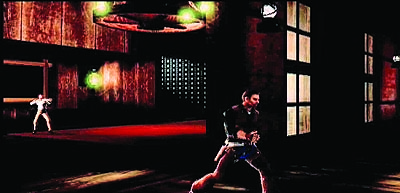By Vicki Bolam, review@ucsc.edu
From roots in computer gaming, interactive digital media are evolving at light speed, becoming vastly more complex and realistic. Richer cinematography and more sophisticated narratives give these "playable media" increasing emotional power and offer more ways for players to author a game's action and outcome.
At the same time, in what are often called "serious games," game-based technologies are transforming education and training in fields such as medicine and emergency response.
Many of these innovations will also have an impact on other media, including film.
"We rely on collaboration and partnership with universities for many of the innovations that fuel our industry," says Ed Catmull, cofounder of Pixar and president of Pixar and Disney Animation Studios. "Many of the most exciting new artistic and technological ideas in the field come from the academic community."
UCSC's computer game design program is creating the future of interactive media. This highly interdisciplinary program meshes engineering, the latest film and new media techniques, as well as research in literary theory, linguistics, and artificial intelligence (AI).

Arnav Jhala
"I see this as a time of enormous potential," says Arnav Jhala, assistant professor of computer science in the Jack Baskin School of Engineering. "With the techniques of gaming, film, arts, humanities, and instructional materials all merging, I feel very lucky to be in this field right now."
The program has become a magnet for top faculty and students from around the country, with Jhala and computer science assistant professor Noah Wardrip-Fruin being two of the latest additions.
One reason computer games are so compelling, says Wardrip-Fruin, is the sense of "agency" they offer players-that satisfying feeling of taking virtual action and changing the virtual world. He wants to create more "intelligent" games that allow players to exercise the kinds of creative strategies used in chess, for example, but applied instead to fictional worlds that respond coherently.

Noah Wardrip-Fruin
He is therefore exploring ways to generate a much broader range of potential game pathways and more ways for users to shape games as they play.
"In other words," he says, "the software won't need to encode hundreds of ways for [Raymond Chandler's fictional detective Philip] Marlowe to solve the mystery, but can instead give players the power to explore, investigate, and decide how to use their knowledge."
Jhala is working to expand the emotional and visual power of games.
"Today's games engage the player at the skill or reactive level," says Jhala, "but not at the deeper emotional or 'mood' level. As games evolve we will expect them to deliver powerful experiences that compare with film."
One of Jhala's research specialties is cinematic communication, analyzing how filmmakers use techniques such as camera angle, lighting, color, and sound to communicate with audiences.
Jhala likens his research to the study of spoken language-but focusing instead on human visual communication. "We're trying to understand how filmmakers communicate visually on an emotional level and apply that to gaming to make it more compelling."
Jhala is also applying AI techniques to make games more interactive. For example, what if a game were "smart" enough to know when a player is stuck and could subtly point her in the right direction? A slight shift in camera angle or lighting, for example, might emphasize clues the player has missed.
Innovations like these are only the beginning, says Wardrip-Fruin. "This stage in the history of interactive media is analogous to the period when novels were first emerging, or when films became more than just acting out a play in front of a camera."
For more information about computer game design at UCSC, visit the Expressive Intelligence Studio.



